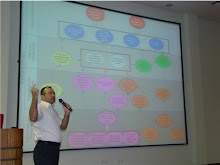I would like to share my understanding about Vision Mission and Objectives by showing how they are linked together.
Vision: A High level description of the desired state. Brief, concise and realistic.
This comes from the Board of directors, Executives, Owners etc. (the top level)
For this vision to come true, many things need to be done, some are inter-related. So, we need to know what is the role of each sub-organization or division (the second level) to enable making this vision real, these are our missions.
Mission statements are developed by communications and discussions between the top level and the second level.
Once agreed upon, each Division will have its Mission which is aligned with and contributes to achieving the Organizational Vision.
Then what? These mission statements are broad high level statements… Here comes the need to breakdown each mission statement into a ‘specific set of objectives’:
• Objectives are precise, clear, and include all the work needed to achieve the mission statement.
• Each objective can be ‘owned’ by a middle manager within the division.
• Each objective has its quantitative measures of success (10% cost savings in operations; new software implemented; Establishing a local office for division X in country Y, Expand workforce to include Z qualified civil engineers etc.)
• The owner can determine how to achieve this objective (develop a plan and determine required resources)
• Division Manager approves the resources based on the plan.
• The owner of the objective is responsible for executing the plan and accountable for realizing the measures of success.
Division Managers can then ‘coach and monitor’ while middle managers ‘plan, execute and report’.
This method presents an example of a top-down approach of the Vision-Mission-Objectives chain; and we should be ready for changes in the working environment as follows:
• Tuning the mission statements and objectives as response to small changes
• Reviewing our vision periodically (annually maybe) and update all the above.
Looking forward to see other views and learn from other experiences.
About The Author

- Eng. Samer el Barakeh, MPM, PMP
- Samer el Barakeh was born in Lebanon, 1973. He completed his Bachelor in Engineering-CCE at Beirut Arab University-Lebanon in 1996 with honours. Samer was granted Masters Degree in Project Management (MPM) from the University of Sydney-Australia with honours. He also gained the Project Management Professional (PMP) Credential from The Project Management Institute (PMI). Samer is a member of the Order of Architects and Engineers in Lebanon since 1996, The Project Management Institute (PMI), Arabian Gulf Chapter (AGC-PMI) and Lebanon Chapter-PMI. During his 13 years of professional experience in Lebanon, Australia and Saudi Arabia, Samer held many positions among them: Telecommunication Site Engineer, Site Manager, Low Current Service Head, and he is currently Senior Systems Analyst at the General Project Construction Division. Samer is a Project Management Consultant and Training Provider for universal organizations like Business Management Consultants (USA) www.bmc-online.com and PMCTQuest (Canada) www.pmctquest.com Samer is a Registered Training Provider for Project Management Professional (PMP), and he provides training in Program Management, Portfolio Management,PMO...
Select a topic to view content
- A comparison between PMBOK and Prince2 Methodologies and reflection on case study examples (1)
- ABC to Avoid Project Failure (1)
- Business Case and Quantitative Benefits (1)
- Do we need more 'Planners' ? (1)
- Fasilitator in Partnering-A Coincise Shot (1)
- How to Ensure Stratgic Alignment of Our Projects? (1)
- Individual Dissimilarity and Team Work (1)
- Knowledge Management (1)
- Maturity Models-The Pros and Cons (1)
- Organizational Advantages from Partnering (1)
- Organizational Maturity: Lets Head Upwards... (1)
- Organizational Strategy and Project Alignement (1)
- Practical Solutions 1 of 6: Introduce RMMM (1)
- Practical Solutions 2 of 6: Facilitate Change to Perk up Maturity (1)
- Practical Solutions 3 of 6: Leverage Organisational Culture Barrier (1)
- Practical Solutions 4 of 6: Organisational Cultural Alignment (1)
- Practical Solutions 5 of 6: Defining a Unified Decision Making Tool (1)
- Practical Solutions 6 of 6: Understanding The Paradox of Control (1)
- Programme Management to Implement Strategy (1)
- Project Management and Construction Management (1)
- Project Managers relocated before Proper Project Closure and Learning Lessons (1)
- Project Managers' Power (1)
- Strategic Planning (1)
- Successful Project Management Office-PMO (1)
- System Thinking: Archetypes at Work... (1)
- The Partnering Change Process (1)
- The Upper Hand… Leadership skills or Processes? (1)
- Thinking about change needed? Maybe you should be more ‘worried’ about how to make it real (1)
- Vision Mission and Objectives What and Why? (1)
- What is meant by Portfolio and Programme Management (1)
- Why Partnering in Organizations? (1)
June 22, 2008
Vision Mission and Objectives What and Why!?
Posted by
Eng. Samer el Barakeh, MPM, PMP
at
12:07 PM
2
comments
![]()
![]()
How to Ensure Stratgic Alignment of Our Projects?
Below is a set of recommendations that can help Organizational executives ensure proper alignment between projects pipelined and their organizational strategy. As a bottom-line, projects and strategic development are inter-related as shown below.
Allow Middle Managers Onboard
Most executives are too busy to be involved in structured strategic planning, some got their positions because they are owners, shareholders or simply powerful; they may not have the practical experience needed for strategic planning. Strategic decisions that are based on top-down approach will be partially implemented especially when middle managers don’t feel that they are ‘right’.
Strategic decisions will have better chances of success if they involve managers from all organizational levels and not only executives (Mintzberg, 1994). This will enrich the strategic planning process and improve the feeling of strategic ownership among organizational levels.
I believe that a structured strategic planning framework should not only consider the above mentioned, but also consider roles for strategic planners as catalysts and feedback loops for optimization (March et al., 1976).
Enhance Alignment by Using Projects to Implement Strategy
Once strategy is planned, there should be a method for implementing it. Many studies have addressed the fact that change is a challenge in strategic implementation. However, projects characteristics can integrate both planned strategy and evolving strategy (Mintzberg, 1987). Strategic decisions can be broken down into smaller components and projects can be planned for these components. Senior management will then have measurable criteria to identify the extent of implementation of each strategic decision being made. So, we can see now how they are inter-related!
Understanding the Strategy-Culture-Project link
It is not only structure that counts, it is people that perform. Strategic decisions should consider the organizational culture. If there is a big gap between organizational culture and strategic decisions, these decisions will not survive. And projects planned to implement these strategic decisions will fail.
Strategy can be implemented by projects. To be successful; these projects should be – to a certain extent- aligned with organizational culture. Once completed, these projects themselves cause a small shift in the organizational culture.
In some cases, projects are pipelined mainly to cause incremental cultural change or overcome a cultural barrier that can enable implementing the desired strategy. Many organizations fail to point this link between culture, strategy and projects; and end up with a bigger misalignment.
Effectively Manage Project Portfolios
This is recommended by establishing a Programme/Portfolio Management Office. PMO benefits were thoroughly discussed in another Discussion Topic, although avoiding repetition, I find it important to mention that establishing a balanced scorecard of quantitative criteria for project selection along with rigid decision gates that periodically kill projects that should be killed and hold those waiting for resources are important PMO roles for aligning projects with strategy (Kaplan & Norton, 2000). .
Establish and Enforce Sound organizational Governance
This topic was also addressed in another topic, but I would like to add something here:
Not only should the organization establish a governance structure with clear Roles and Responsibilities, Authorities, Power… but measures should be set to ensure that this governance structure is actually being implemented.
Importance of governance increases at higher levels because that is where most of the influence resides and unfortunately, less monitoring and control. It is not easy to face ‘powerful executives’ with alternative strategies. Those that do so, according to Gordon Donaldson (1995), run the risk of finding themselves isolated, and in time, replaced.
The solution presented in this same article can help resolve the strategic alignment issue on the executive’s level by “strategic Audits”: A formal strategic review process, managed by a committee of independent directors supported with authority.
These strategies, among others, are essential to ensure proper alignment between projects and organization’s strategy. However, I see that the key challenge resides in ‘implementing’ them. Each organization has to integrate its specific conditions, type of business, the pace of strategic change, working environment, and other factors in order to select the right portfolio of practices that suit its needs.
References:
• Donaldson G. (1995), ‘A new Tool for Boards: The Strategic Audit’, Harvard Business Review. pp: 99-107
• Kapalan R.S., Norton D.P. (2000), “Having Trouble With Your Strategy? Then Map it”, Harvard Business Review, September-October 2000, pp.167-176
• March J. and Olsen J. (1976), “Ambiguity and Choice in Organizations”, p.80, Universitetsforlaget, Bergen, Norway.
Posted by
Eng. Samer el Barakeh, MPM, PMP
at
1:24 AM
2
comments
![]()
![]()















